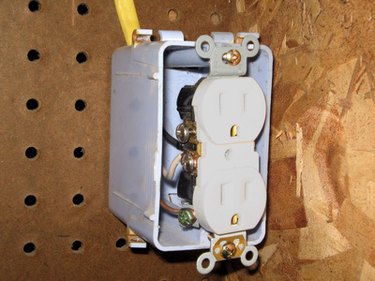Things You'll Need
Tape measure
Stud finder
Pencil
Outlet junction box
Safety glasses or goggles
Drywall saw
Screwdriver
Circuit tester
Cable connector
Electrical wire
Wire cutters
Cable ripper
Wire stripper
Outlet
Lineman's pliers
Wire nuts

There may come a time when you find it necessary to have electricity available in a place where there is no existing electrical outlet. Rather than running an extension cord to that spot, you decide that you would like to install another electrical outlet there. With some basic tools and the right parts, you can wire a new outlet from an existing one in a few hours.
Step 1
Choose an existing outlet in an adjoining room that is close to the place where you would like to add the new outlet. Place the stud finder against the wall on either side of the outlet. Measure the distance from this stud to a doorway or the corner of the room. If the outlet is between the stud and this benchmark, subtract 8 inches from the measurement. If it is on the opposite side of the stud, add 8 inches. This will ensure that the wiring from the existing electrical box will be accessible without having to drill a hole in the stud.
Video of the Day
Step 2
Measure that same distance on the side of the wall where the new outlet will be installed and make a small pencil mark on the wall. Place the face of the new junction box against the wall at this point and trace around it. Turn the power to the circuit off at the breaker box. Plug the circuit tester in to the existing box to be sure the circuit has no power.
Step 3
Put on the safety glasses or goggles. Cut the hole for the new box with the drywall saw, taking care not to cut any wires that may be inside the wall. Remove the faceplate from the existing outlet. Unfasten the two screws that hold the outlet to the box and gently pull the outlet away from the box. Remove a knockout hole in the box by sliding the screwdriver between the knockout cover and the box. Twist the screwdriver enough so that the knockout can be gripped with the pliers. Twist the pliers until the knockout comes off. Place a cable connector in the knockout hole and tighten the lock nut.
Step 4
Push the new cable through the existing box and toward the hole that you've cut. Pull the wire through the hole, leaving about 8 inches protruding from it. Leaving 8 inches of wire sticking out of the existing box, cut the wire with the wire cutters. Push the cable through the new box. Push the box into the new hole. Tighten the screws that have the clamp tabs attached to them until the box is securely fastened to the drywall.
Step 5
Remove the outer sheathing of the cable that is protruding from each box, using the cable ripper. Remove 3/4 inch of insulation from the ends of the black and white wires with the wire strippers. Using the lineman's pliers, create a hook on the ends of the black and white wires at both ends. Connect the black wire to the bronze terminal on the outlet plugs and tighten the screw. Attach the white wires to the silver terminals.
Step 6
Remove the wire nut connecting the bare ground wires at the existing box. Twist the new ground wire together with the existing ones with the lineman's pliers. Replace the wire nut. Since you are adding another wire, it may be necessary to use a larger wire nut on this connection. At the new box, make a hook on the end of the ground wire and attach it to the green terminal of the outlet. Push the wires at each outlet into the box and connect the outlet to the box with the screws provided. Screw the faceplate onto each outlet. Restore power and use the circuit tester to make sure power is running to both outlets.
Tip
Purchase a "remodeling" style junction box. Some stores designate them as "old work" boxes. These boxes do not have to be attached to studs. Do not overtighten the clamp tabs on the new box, since it may pull the box through the wall.
Video of the Day